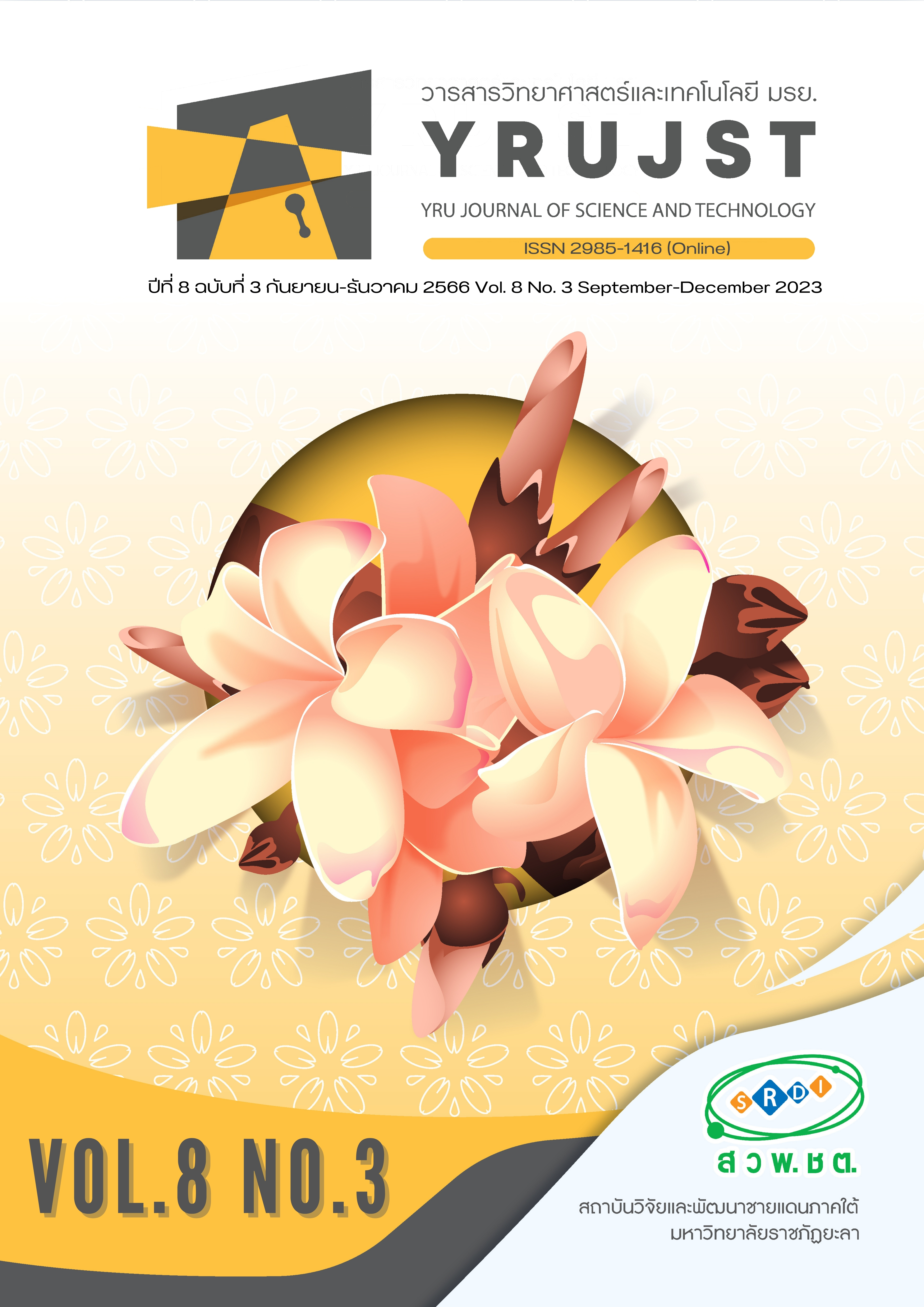Development of Nourishing Skin Cream Containing Siw Gliang Rice Extract
Main Article Content
Abstract
Native rice has nutritional value and essential bioactive compounds despite being less popular than other rice varieties. Developing cosmetic products mixed with rice extracts can be an interesting option for increasing the value of native rice. Siw Gliang, as native rice, has been developed into a skincare product. This study was to investigate the antibacterial activity of Siw Gliang rice extracted with ethanol and ethyl acetate against 8 pathogenic bacteria (S. aureus TISTR 517, S. Typhimurium TISTR 292, B. cereus, E. coli TISTR 780, P. vulgaris, P. aeruginosa TISTR 781, A. hydrophila, and S. marcescens) using Agar well method. The result showed that the rice extracted with ethyl acetate at a concentration of 500 mg/mL had the highest antibacterial activity efficacy of S. aureus. The Siw Gliang rice extracted with ethanol and ethyl acetate showed inhibitory activity against tyrosinase enzyme with 50% inhibitory concentration (IC50) values of 12.32±1.30 and 105.04±5.45 µg/mL, respectively. The stability study of the formulation of nourishing skin cream containing Siw Gliang rice extract was performed for 1 month. The physical and chemical characteristics were evaluated. The result showed that the nourishing skin cream spread easily on the skin and had a pH suitable for use on the skin. This research indicated that Siw Gliang rice has great potential to produce value-added products and continue commercializing.
Article Details

This work is licensed under a Creative Commons Attribution-NonCommercial-NoDerivatives 4.0 International License.
บทความ ข้อมูล เนื้อหา รูปภาพ ฯลฯ ที่ได้รับการเผยแพร่ในวารสารวิทยาศาสตร์และเทคโนโลยี มรย. นี้ ถือเป็นลิขสิทธิ์ของวารสารวิทยาศาสตร์และเทคโนโลยี มรย. หากบุคคลหรือหน่วยงานใดต้องการนำทั้งหมดหรือส่วนหนึ่งส่วนใดไปเผยแพร่ต่อหรือกระทำการใดๆ จะต้องได้รับอนุญาตเป็นลายลักษณ์อักษรจากวารสารวิทยาศาสตร์และเทคโนโลยี มรย. ก่อนเท่านั้น
References
Buachoon, N. 2020. Antioxidant activities and tyrosinase inhibition activity from crude extracts of Psidium guajava L. VRU Research and Development Journal, 15(1), 1-12. (in Thai)
Eiamthaworn, K., Kaewkod, T., Bovonsombut, S. & Tragoolpua, Y. (2022). Efficacy of Cordyceps militaris extracts against some skin pathogenic bacteria and antioxidant activity. Journal of Fungi, 8, 327, 1-15.
Henley-Smith, C. J., Steffens, F. E., Botha, F. S. & Lall, N. (2014). Predicting the influence of multiple components on microbial inhibition using a logistic response model - a novel approach. BMC Complementary and Alternative Medicine, 14, 190, 1-10.
Homklob, J., Winitchai, S., Rimkeeree, H., Luangprasert, M. & Haruthaithanasan, V. (2010). Free radical scavenging capacity, tyrosinase inhibition activity and total phenolics content of ethyl acetate extracts from Indian gooseberry (Phyllanthus emblica L.) in Thailand. Proceeding of 48th Kasetsart University Annual Conference: Agro-industry, February 3-5, 2010. Bangkok: Kasetsart University. (in Thai)
Kim, Y. R. & Uyama, H. (2005). Tyrosinase inhibitors from natural and synthetics source: structure, inhibition mechanism and prospective for the future. Cellular and Molecular Life Science, 62, 1707-1723.
Koodkaew, I & Sukonkhajorn, P. (2018). Antioxidant and anti-tyrosinase properties of stem, leaf, flower and seed from garden balsom. Khon Kaen Agricultural Journal, 46 (supplement1), 1242-1247. (in Thai)
Kongwong, R. & Wattananamkul, V.(2011). A study of “Harmful cosmetics” usage behavior among female teenagers in Ubon Ratchathani Province. Isan Journal of Pharmaceutical Sciences, 7(1), 76-87. (in Thai)
Koohsari, H., Ghaemi, E. A., Sadegh Sheshpoli, M., Jahedi, M. & Zahiri, M. (2015). The investigation of antibacterial activity of selected native plants from North of Iran. Journal of Medicine and Life, 8 (special issue 2), 38-42.
Kumwing, S.(2018). Development of nourishing skin cream from Tubtim chum phae rice extract. Bachelor degree’s Thesis. Nakhon Sawan Rajabhat University. (in Thai)
Lichanporn, I., Nantachai, N., Tunganurat, P., & Akkarakultron, P. (2019). The studies of phenolic compound and antioxidant of the native varieties of rice in Pathum Thani Province. Khon Kaen Agricultural Journal, 47 (Supplement 1), 637-642. (in Thai)
Long, Z. P., Hyang, R. P., Yun, K. P., Seung, K. L., Jeong, H. P. & Man, K. P. (2002). Mushroom tyrosinase inhibition activity of some chromones. Journal Chemical and Pharmaceutical Bulletin, 50(3), 309-311.
Merola, J. M., Shane, M., Ruth, F. W. & Lance, B. (2008). Exogenous ochronosis. Dermatology Online Journal, 14 (10), 6.
Mishra, A. K., Yadav, P. & Mishra, A. (2016). A systemic review on staphylococcal scalded skin syndrome (SSSS): a rare and critical disease of neonates. The Open Microbiology Journal, 10, 150-159.
Narenut, K., Sanitchon, J. & Songri, P. (2011). Selection of Indigenous upland rice for early drought tolerance. Khon Kaen Agricultural Journal, 39 (supplement 2), 67-71. (in Thai)
Phengrat, J., Jearakongman, S., Suriyaarunroj, D., Konghako, P., Pasopa, S., Saleetho, S., et al. (2011). Sew Gliang specific-region upland rice of Loei province. Proceeding of 2nd Rice annual conference year 2011: Rice and national farmers' day. June 3-4, 2011. Bangkok: Rice Department. (in Thai)
Srisuksomwong, P., Kaenhin, L. & Mungmai, L. (2023). Collagenase and tyrosinase inhibitory activities and stability of facial cream formulation containing cashew leaf extract. Cosmetics, 10 (17), 1-10.
Thongtan, J. & Phupong, W. (2017). The application of red jasmine rice bran oil and its extract for skincare. VRU Research and Development Journal Science and Technology, 12(2), 43-56. (in Thai)
Thongkum, T., Sukatta, U., Rugthaworn, P., Khinsukhon, K., Kacharat, L., Sakayaroj, S., et al. 2020. Antioxidant and tyrosinase inhibition properties of extract from rambutan peels (Nephelium lappaceum L.) for cosmetic products. Proceeding of 58th Kasetsart University annual conference: Science, Engineering and Architecture, Agro-Industry, Natural Resources and Environment, February 5-7, 2020. Bangkok: Kasetsart University. (in Thai)
Torgbo, S., Rugthaworn, P., Sukatta, U. & Sukyai, P. (2022). Biological characterization and quantification of rambutan (Nephelium lappaceum L.) peel extracts as a potential source of valuable minerals and ellagitannins for industial applications. ACS Omega, 7, 34647-34656.
Wattana, W., Poungraya, K. & Sudta, P. (2022). Antioxidant and tyrosinase inhibitory activities of the extracts from Fresh and dried leaves of Suaeda maritime L. Srinagarind Medical Journal. 37(1), 72-75. (in Thai)


